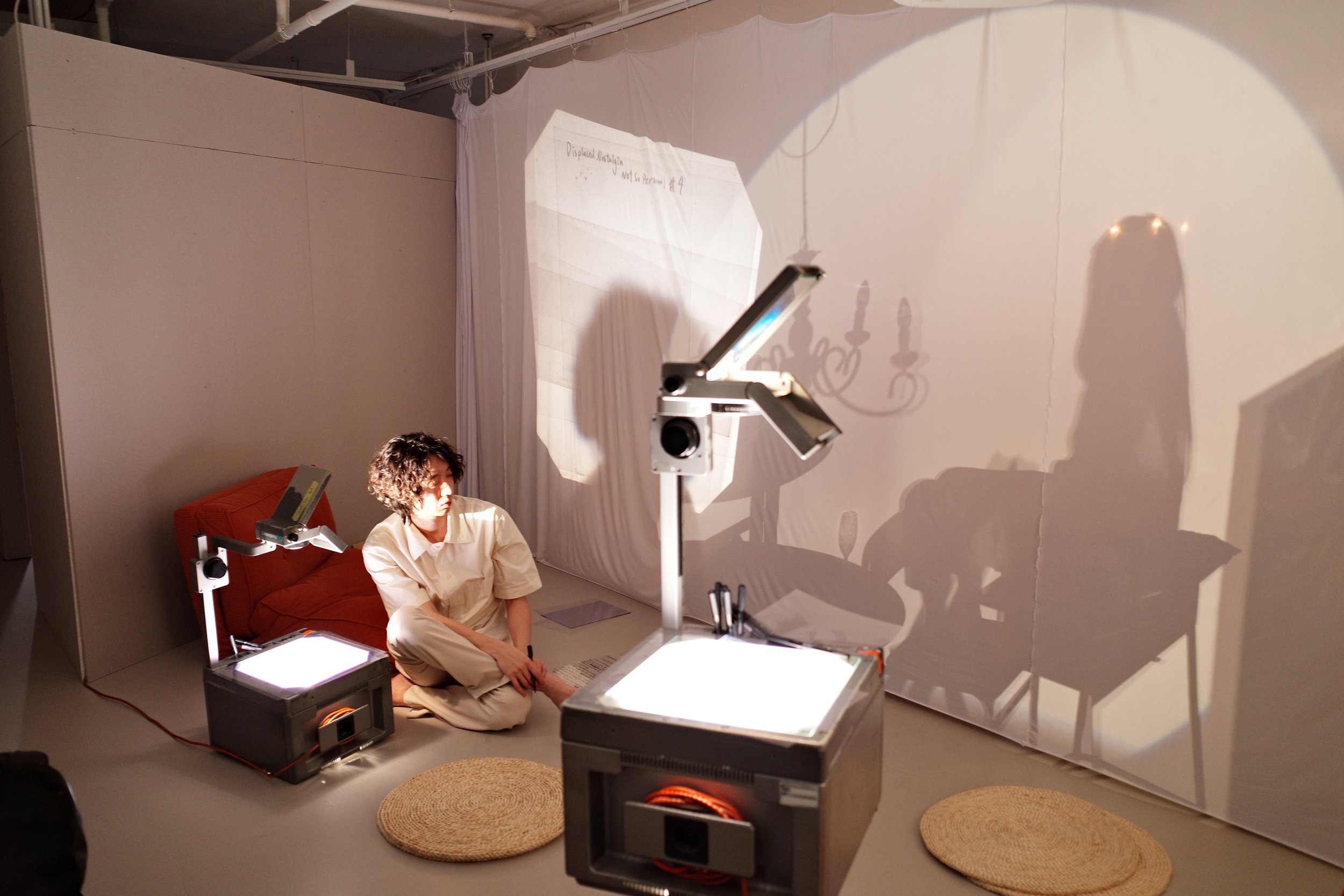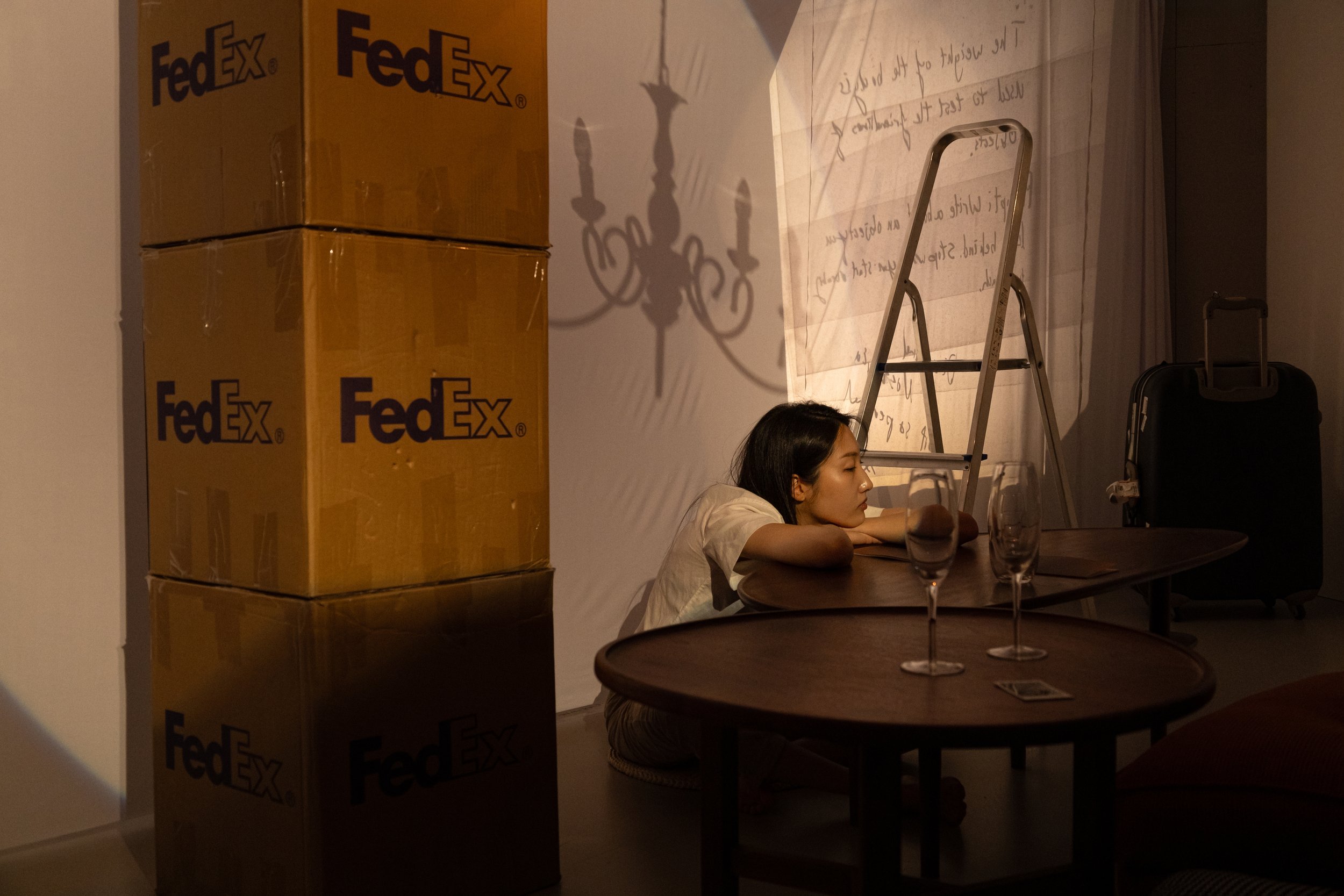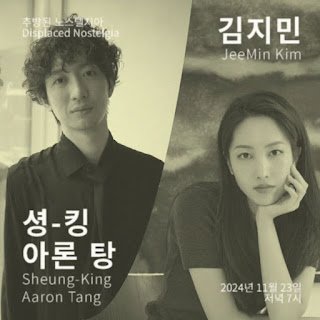Displaced Nostalgia
How can durational performances, where representations of time are removed from the setting, create space for individuals to express their feelings of displacement and nostalgia through creative writing?
JeeMin Kim and Sheung-King form a duo whose project, Displaced Nostalgia, examines nostalgia, hope, and identity within diaspora. Initiated in Seoul, South Korea, in 2024, the project uses long-form performance to create space for rest within accelerated time, allowing participants to reflect on belonging and displacement. By intersecting art-making, creative writing, and audience participation, these performances also function as interview techniques, a form of research-creation that elicits data from their participants.
Writings:
Displaced Nostalgia: Not So Personal (2025),
Displaced Nostalgia: Entries (2024)
Performances:
JeeMin Kim & Sheung-King
28 March 2025
WMA Space, Central, Hong Kong
The contemporary overflow of information prioritizes the immediate over analysis or mediation, leading to a life that lacks reflection and focus. Amidst the dynamic bustle of March’s cultural events, can we carve out a space where the audience can breathe and immerse themselves in contemplation? WMA invites artist Jeemin Kim and novelist Shueng-King Aaron Tang, who has lived in multiple locations, to present a durational performance titled “Displaced Nostalgia: Not So Personal,” interpreting and responding to Anson Mak’s “No Such Person.” The performance invites audiences to lay aside their devices and enter, wander, and exit freely in a realm where time and space blur. With a fresh perspective, they can attune themselves to the fluidity of time and ponder the intricate connections between displacement and the notion of home. As Kim rearranges and projects household objects, Tang responds through the act of writing, inviting participants to immerse themselves in a shared experience that is both deeply personal and collectively resonant.
*Over the course of the performance, which lasts for 7 hours, registered audiences are free to enter or leave the space at any point. Click here for more information.
Displaced Nostalgia: Not So Personal (2025), Courtesy of Joyce Li
Displaced Nostalgia: Not So Personal (2025), Courtesy of WMA and Chuk Yin Man
Bad Timekeepers
20 November - 24 November 2024
TINC(This is Not a Church), Seoul, Korea
𝘽𝙖𝙙 𝙏𝙞𝙢𝙚𝙠𝙚𝙚𝙥𝙚𝙧, a series of public events where our invited Bad Timekeepers explore labor, time, technology, and decolonial strategies, challenging and dismantling the oppressive systems inherited from colonial rule. They focus on reclaiming cultural practices, knowledge systems, and narratives that have been erased or marginalized. Through the perspectives of Black, Indigenous, People of Color, immigrants, and LGBTQ+ communities, these strategies aim to reimagine power structures, promote self-determination, and center voices historically excluded. Our narrative is an insurgent tapestry woven from speculative yet familiar alternatives.
The program will feature a constellation of visionary thinkers and creators, including Nobutaka Aozaki, Julie Chen, Sun-ha Hong, Hobin Kim, Kwang-Suk Lee, Inkang Lee, Seam Lee, Yutong Lin, Casey Mecija, Ying Sze Pek, Ryan Persadie, Sarah Sharma, Mindy Seu, Su Yu Hsin, Asmita Bustani Vij, Choonhee Woo, Yufeng Zhao, Sheung-King Aaron Tang & JeeMin Kim, and Diasporic Futurism (Vanessa Godden and Adrienne Matheuszik).
Our journey begins in Toronto and Seoul, with a constellation of thinkers and creators shaping these new temporal realities. Grateful for the support of InterAccess, Charles Street Video and the Jackman Humanities Institute at the University of Toronto that make this work possible.
Displaced Nostalgia: Ritual
23 November 2024
TINC(This is Not a Church), Seoul, Korea
Displaced Nostalgia: Rituals (2024) with Bad Timekeepers
As part of 𝘽𝙖𝙙 𝙏𝙞𝙢𝙚𝙠𝙚𝙚𝙥𝙚𝙧𝙨, 𝘿𝙞𝙨𝙥𝙡𝙖𝙘𝙚𝙙 𝙉𝙤𝙨𝙩𝙖𝙡𝙜𝙞𝙖: 𝙍𝙞𝙩𝙪𝙖𝙡 uses the ability of rituals to escape accelerated time to interrogate nostalgia. The artist begins by laying bricks on the floor to create a sandbox, with a light hanging from the ceiling. The artist’s structure, influenced by ancient Roman compluvium and impluvium, represents time, mimicking how sunlight shines through the roof and onto the sand. But our ritual takes place at night. There is no sun. Here, the JeeMin Kim is the “Badtimekeeper.” When she feels an hour has passed, she adjusts the light that hangs from the ceiling. The positioning of the light that shines on the sandbox reflects the artist’s perception of an hour. Each hour, the writer composes a piece of writing on nostalgia, which is projected onto the sand. This process will be repeated five times over. Accompanying the performance are wall texts and booklets responding to the term "𝘿𝙞𝙨𝙥𝙡𝙖𝙘𝙚𝙙 𝙉𝙤𝙨𝙩𝙖𝙡𝙜𝙞𝙖."






